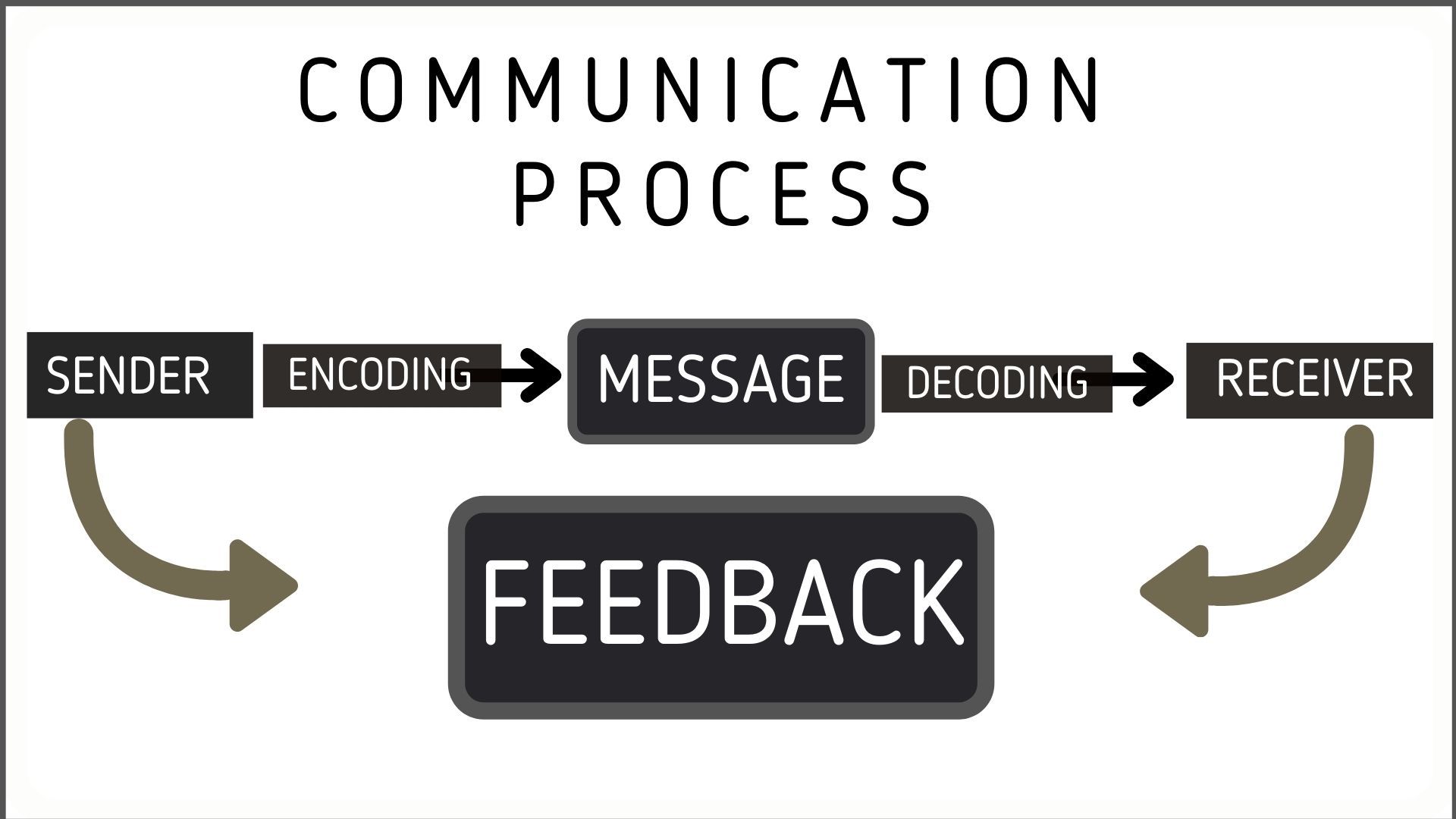
What is Communication Process? Understanding the Importance and Examples

The communication process is a two-way system where a message is conveyed from the sender to the receiver, involving steps such as encoding, selection of communication channel, decoding, and feedback It's essential for effective communication and can be improved through active listening and clear messaging Examples include face-to-face conversations, phone calls, emails, and text messages
Effective communication involves a two-way exchange of messages, ideas, thoughts, feelings, or opinions between at least two individuals. This exchange takes place through a communication channel, with the aim of achieving shared understanding.
The communication process is dynamic and starts with the sender conceptualizing their ideas. It then moves through six other elements, including encoding, message creation, channel selection, the receiver, and finally, the receiver decoding the message.
The way in which individuals communicate with each other, whether in a business, professional, or personal setting, is crucial for successful interaction. In this article, we will delve into the intricacies of communication, including its various channels, obstacles, non-verbal cues, and proper utilization. Let's begin our exploration now with
What is the Communication Process?
The Communication process involves four key components: encoding, medium of transmission, decoding, and feedback. These elements work together to facilitate the transmission of information from the sender to the receiver. Additionally, effective communication requires overcoming any barriers that may hinder the process. Ultimately, the communication process begins with the sender and concludes with the receiver.
Effective communication is a cyclical process that involves a sender and a receiver, with negative feedback completing the loop. It encompasses the actions and steps taken by two or more individuals to exchange their thoughts and ideas.
To achieve successful communication, several components are necessary, with each playing a critical role. The primary objective is to ensure that the receiver comprehends and interprets the message conveyed by the sender accurately.
These are the several parts that are essential to an effective communication cycle:
1. Sender
The person responsible for initiating and conceptualizing the communication is the sender, who sends the message to the intended receiver.
2. Encoding
The message sent by the sender is encoded based on their thoughts and can be conveyed through various methods, including verbal and non-verbal means such as symbols, body language, and signs. The quality of the encoded message is influenced by the sender's background, knowledge, skills, and competency.
3. Message
The key element in effective communication is the message conveyed from the sender to the receiver. This message serves to establish a shared understanding, convey information or communicate a specific message to the receiver through the communication channel.
4. Communication Channel
The choice of communication channels is crucial to ensure effective message delivery. It is important for senders to carefully consider the receiver's preferences and level of comfort with various visual mediums.
5. Decoding
Here, a receiver decodes the message for proper interpretation and effective channelization of the process of communication.
6. Receiver
The recipient plays a crucial role in the communication process by receiving, decoding, understanding, and interpreting the message sent by the sender. It is imperative that the message is delivered accurately to ensure a successful outcome, and the recipient may provide feedback if necessary.
7. Feedback
The final stage of communication is feedback, which allows the receiver to confirm that they have received and understood the message as intended by the sender.
Importance of Communication Process
Effective communication is crucial in both personal and professional settings. It enables individuals to share ideas, express thoughts, and convey messages with clarity, precision, and accuracy. Good communication skills are essential for building relationships, resolving conflicts, and strengthening teamwork. Without effective communication, misunderstandings can arise, leading to confusion, frustration, and even conflict. Therefore, it is critical to understand the importance of communication in all aspects of life.
Understanding each other's thoughts and ideas is crucial for effective coordination among individuals in any organization. It helps to ensure that everyone is on the same page and working towards the same goals, which is essential for the smooth and efficient functioning of the team. A worker who can communicate fluently and in an organized manner is an asset to any organization.
It is essential in decision-making. In the absence of proper communication, no proper and efficient decision-making is possible.
It helps in increasing managerial efficiency in organizations.
By fostering a sense of peace and cooperation among employees at all levels of the hierarchy, it creates a more positive and productive workplace culture. Additionally, this approach can help to increase employee morale and promote overall well-being by creating a healthier and more supportive environment for all staff members. Overall, promoting organizational peace and cooperation is an essential part of fostering a successful and sustainable workplace environment.
How does the Communication Process work?
To ensure the success of a communication process, it is essential to have a comprehensive understanding of the fundamental elements that govern it. In order to channel a communication process effectively, it is important to consider some of the key steps involved.
1) Development of the idea to be sent
To effectively communicate with an audience, the sender must first conceive an idea or topic that they wish to convey. This initial step involves careful consideration of the subject matter and the intended recipients of the message. The sender must ensure that the idea is formulated in a way that will be easily understood by the target audience.
2) Encoding of the message by the sender
After formulating an idea, the sender must then encode the message into a format that can be comprehended by the recipient. This can take the form of oral communication if the sender is utilizing nonverbal cues, or written communication if the sender is composing a letter or other written document. The chosen form of communication must effectively convey the sender's thoughts and ideas to the intended audience.
3) Selection of the channel that will be used for communication
This is now followed by the selection of the channel that will be used for the transmission of the message.
There are various communication channels available, such as electrical transmission, nonverbal mediums, and verbal communication. However, in a professional setting, it is crucial to use a more formal and structured approach to communication.
4) Message traversing the channel of communication
The success of conveying your message relies heavily on the medium chosen for communication. Once the channel is established, the message can be transmitted through the process of communication. It is crucial to select the appropriate medium for the effective and organized delivery of the message.
5) Receival of the message by the receiver
The message ultimately reaches the receiver after traversing the entire medium. This marks the receptive stage of communication, wherein the receiver can absorb the message through various means such as listening, reading or even feeling it.
6) Decoding of the message by the receiver
7) Interpretation followed by feedback if desired
After the message is successfully received by the sender, it undergoes decoding, which involves interpreting and converting it into a coherent thought. Following this, the receiver will analyze and try to comprehend the message. This process is more efficient when the same medium is utilized for both the transmission and receipt of the message by the sender and the receiver.
How to Improve the Communication Process?
Feedback is an essential part of two-way communication. Although not mandatory, the recipient may choose to provide feedback to the sender in the form of a reply. This allows the sender to confirm that their message was properly understood and received by the recipient. By providing feedback, both parties can ensure effective communication has taken place.
Clear and concise communication is essential for success, whether as an individual, organization, or large corporation. To improve your communication skills, focus on delivering your message in a straightforward and uncomplicated manner, ensuring that your point is easily understood.
To effectively communicate with your audience, it is crucial to have an understanding of their interests and needs. This allows for a more in-depth discussion that can keep them engaged and interested. One way to ensure this engagement is through asking relevant and appropriate questions throughout the conversation.
Understand the question before responding to it. Take your time to frame a well-thought-out answer that is reasonable. Additionally, pay attention to your body language when communicating through different mediums as it can reveal a lot about your personality and help to engage your audience.
Maintain eye contact when speaking to someone as it shows respect and keeps them engaged in the conversation. If there is any confusion about the message you've communicated, take the time to clarify it to ensure better understanding.
Always being receptive to suggestions from others is crucial. Gaining insights from different perspectives can prove to be beneficial in comprehending things that might be difficult to understand otherwise. This approach is not only considerate, but also demonstrates your flexibility and willingness to adapt to new ideas.
Communication Process Example
Here is an example of a communication process being carried out in an office environment
Sender: I want to make a promotional strategy for my website along with my team of employees.
I convert my thoughts and ideas into a tangible form using PowerPoint software, creating a comprehensive promotional plan for the company. The resulting PowerPoint presentation serves as the vehicle for conveying the message and promoting the website.
I share the PowerPoint presentation with my team via email or host a Zoom meeting to personally present and delegate their tasks in the content creation process.
After decoding the PowerPoint, my team members are encouraged to provide feedback. They may ask clarifying questions, offer innovative ideas, or even predict potential obstacles in the promotional strategy. This enables me to gather valuable insights from my team and prepare for any potential challenges.
However, it's important to note that there are various sources of noise that can hinder effective communication. For example, technical difficulties such as a malfunctioning PowerPoint presentation can cause disruption. Additionally, the absence of a team member who was meant to present their ideas can also lead to a breakdown in communication. It's crucial to be aware of these potential obstacles and work to minimize their impact in order to ensure successful communication.














